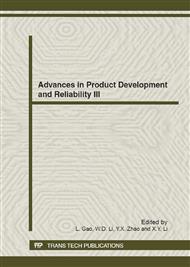[1]
Duško Kančev, Marko Čepin. Evaluation of risk and cost using an age-dependent unavailability modelling of test and maintenance for standby components [J]. Journal of Loss Prevention in Process Industries, 24(2), 2011:146-155.
DOI: 10.1016/j.jlp.2010.12.003
Google Scholar
[2]
Ebrahimipour, Suzuki, Azadeh, 2006. A synergetic approach for assessing and improving equipment performance in offshore industry based on dependability [J]. Reliability engineering and system safety, 91(1), 2006:10-19.
DOI: 10.1016/j.ress.2004.11.008
Google Scholar
[3]
S.A. Martorell, V.G. Serradell, P.K. Samanta. Improving allowed outage time and surveillance test interval requirements: a study of their interactions using probabilistic methods [J]. Reliability engineering and system safety, 47(1), 1995:119-129.
DOI: 10.1016/0951-8320(94)00043-n
Google Scholar
[4]
R.J. Cizelj, B.Mavko, I.Kljenak. Component reliability assessment using quantitative and qualitative data [J]. Reliability engineering and system safety, 2001, 71:81-95.
DOI: 10.1016/s0951-8320(00)00073-9
Google Scholar
[5]
Marko Čepin, Borut Mavko. A dynamic fault tree [J].Reliability engineering and system safety, 75, 2002; 83-91.
DOI: 10.1016/s0951-8320(01)00121-1
Google Scholar
[6]
Radim Briš. Parallel simulation algorithm for maintenance optimization based on directed Acyclic Graph [J]. Reliability engineering and system safety, 93, 2008:852-862.
DOI: 10.1016/j.ress.2007.03.036
Google Scholar
[7]
M.Marseguerra, E.Zio. Optimizing maintenance and repair policies via a combination of genetic algorithms and Monte Carlo simulation [J]. Reliability engineering and system safety, 68, 2000:69-83.
DOI: 10.1016/s0951-8320(00)00007-7
Google Scholar
[8]
Duško Kančev, Blaže Gjorgiev, Marko Čepin. Optimization of test interval for aging equipment: A multi-objective genetic algorithm approach [J]. Journal of Loss Prevention in Process Industries, 24(4), 2011:397-404.
DOI: 10.1016/j.jlp.2011.02.003
Google Scholar
[9]
M.Marseguerra, E.Zio. Optimizing maintenance and repair policies via a combination of genetic algorithms and Monte Carlo simulation [J]. Reliability engineering and system safety, 68, 2000:69-83.
DOI: 10.1016/s0951-8320(00)00007-7
Google Scholar
[10]
J.K. Vaurio.Optimization of test and maintenance intervals based on risk and cost [J]. Reliability engineering and system safety, 49(1), 1995:23-36.
DOI: 10.1016/0951-8320(95)00035-z
Google Scholar
[11]
M. Čepin, B. Mavko. Probabilistic safety assessment improves surveillance requirements in technical specifications [J]. Reliability engineering and system safety, 56(1), 1997:69-77.
DOI: 10.1016/s0951-8320(96)00138-x
Google Scholar
[12]
J.K. Vaurio. Safety-related decision making at a nuclear power plant [J]. Nuclear engineering and design, 185(2-3), 1998:335-345.
DOI: 10.1016/s0029-5493(98)00225-8
Google Scholar


